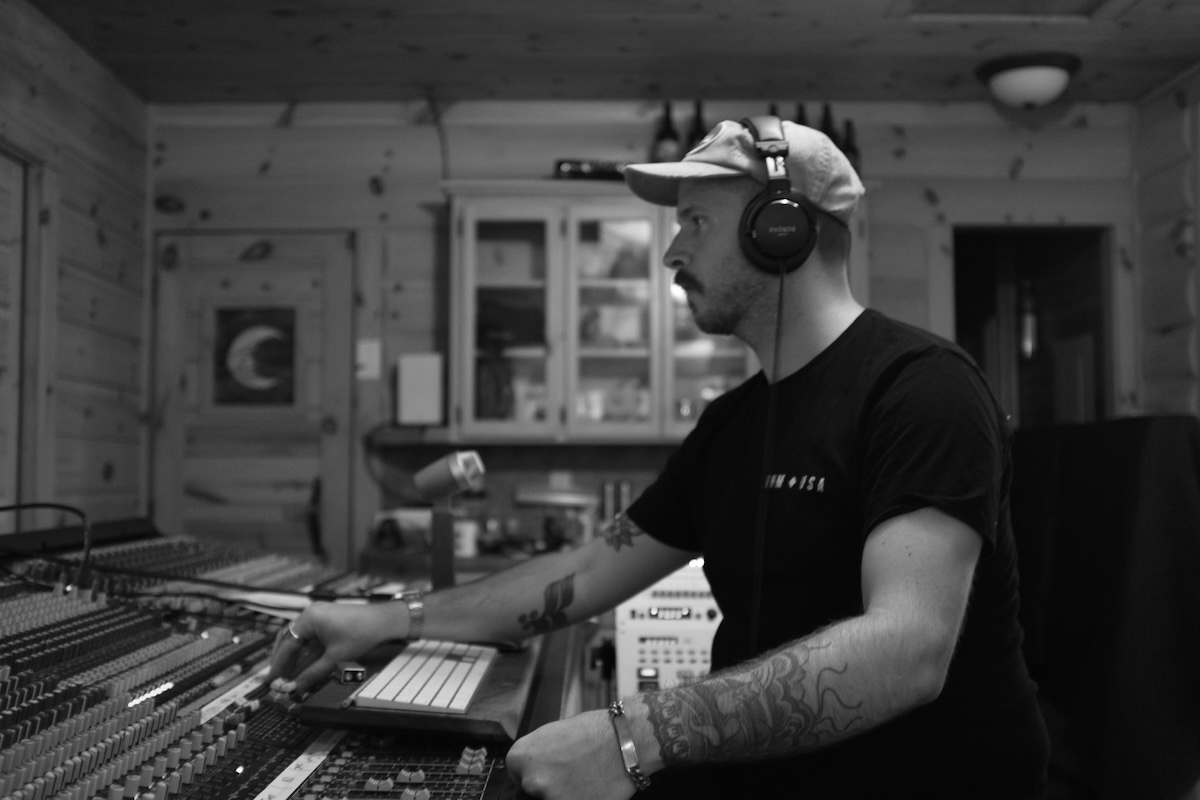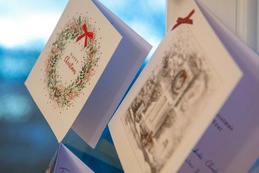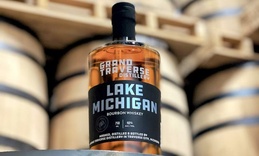
Nick Nagurka and the Art of Mixing
What makes a great record?
By Matt Dursum | Aug. 30, 2025
Balance, harmony, beauty, and storytelling that grabs our hearts are just some of the things that go into a great song. In the studio, it’s up to mixers and engineers like Nick Nagurka to capture moments and complex feelings through sound.
Nagurka’s portfolio includes Theo Katzman, May Erlewine, Vulfpeck, and Yo La Tengo. Instead of working from a studio in Hollywood or New York, he mixes music right here in northern Michigan.
Local Inspiration
“I grew up in Harbor Springs and had some really great teachers in school,” says Nagurka. Superstar music teachers such as Randy Marquardt, Jeff Bennett, and guitar teacher Chris Koury inspired Nagurka to study music. “Chris is the one who got me into recording, and I got into it to prove to myself I could, like, rip on the guitar, because I could never really do it in person.”
With an eight-track Tascam 488 cassette recorder gifted to him by his parents, Nagurka set up his studio in his basement and went to work.
“My guitar teacher at the time, Chris Koury, also had one of those machines, so we could bring tracks back and forth between guitar lessons and home,” he says. Koury loaned him a drum machine, and Nagurka recorded demos on cassettes with his friends. “I loved music. I loved listening to music, and that was just kind of the gateway into recording,” he says.
Although he claims he doesn’t play well, Nagurka is proficient in piano, bass, guitar, and trumpet. But as he prepared for college, Nagurka realized he lacked experience using the electronic software most studio professionals were accustomed to.
“It was great, but it was also pretty limiting trying to emulate sounds that I’d heard on recordings, and just not getting there,” he says. He recorded his music portfolio for the University of Michigan on cassette tape. “When I got there, all these kids around me were like, ‘Oh yeah, I know how to use MIDI, and I know how to make beats.’”
University of Michigan’s Fine Arts in Performing Arts Technology program gave Nagurka the multi-disciplinary outlet he needed. “It’s sort of split between engineering school, art school, music school, and maybe a little bit of film school too,” says Nagurka, who took all the advanced recording classes he could.
Big City Living
After graduation, Nagurka moved to New York with his then-girlfriend, now wife. “She had gotten a great job there, and that was perfect for me, because I wanted to get into a New York studio and kind of get my butt kicked for a while,” he jokes.
Nagurka’s career in New York started slowly, “but just luckily, through a friend, I got this gig at Brooklyn recording as an assistant.” Brooklyn Recording’s portfolio includes artists such as Cheap Trick, Ani DiFranco, Norah Jones, and The Kills.
Recording engineer Andy Taub took him under his wing, giving Nagurka the skills and confidence to take on mixing for Grammy-winning artists.
“You don’t have input when you’re an assistant in a studio—you do it the way the engineer tells you to, or the client asks you to. You get to learn the ways you would want to do something, the ways you wouldn’t want to do something, the ways you want to treat people, and the ways you really don’t ever want to treat people.”
While working in Brooklyn, Nagurka worked with some of the best artists and recording engineers in the business. “There are a lot of absolutely insane artists that came through there,” he says. When he started, the studio had just finished mixing Keith Richards’ solo album.
One prolific artist who made an impact on Nagurka was drum producer Steve Jordan.
“Steve was the first person I ever met who would come in after a take, after just crushing it, and sit right in the middle of the console in the control room, take the volume knob, and turn it up before I even hit play,” says Nagurka. The deafening levels hit like a shockwave, even with earplugs. “It was just rocking out and just such high energy. It was really fun.”
Recording, mixing, and sound engineering can be a thrill, but Nagurka says the biggest challenge lies in developing a common language with the artist.
“You know when somebody says ‘clarity,’ my version of clarity may mean something completely different. Or they say they want it to sound warm—how do you define warm? Whatever it is, it’s just developing that sort of commonality, that little musical encyclopedia where everyone is sort of reading from the same page.” Once that’s developed, Nagurka says the process becomes inspiring.
A Change of Pace
Although he was having fun professionally in New York, things changed quickly during COVID. At the time, Nagurka was on tour with Theo Katzman as his front of house mixer, mixing the sound for the audience. “It was this weird situation where we were driving from Cincinnati to Detroit, and we were about to play our third to last gig of that tour, and we got a call from management that was like, ‘Hey, you gotta cancel these last three shows.’”
After cancelling the tour, Nagurka returned home to his New York apartment, where he and his wife spent several months in lockdown. “It just turned into a high-pressure situation in New York,” he says. Together, they left the brutal New York summer for Traverse City.
After making the move, Nagurka returned to music. He now works out of a home studio, a far cry from his life in New York. “The slower pace of life really allows me to take advantage of being outside, going to the beach, and spending time in the water. I think it helps my work, having the space go down into a room to work instead of having to commute,” he says.
When Nagurka gets into the zone, even the beauty of northern Michigan becomes a distant thought. “When I’m mixing, I just sort of float into space somewhere, and I could be gone for hours. It’s like you're forgetting about the rest of the world, but it’s so nice to get into the world again.”
Nagurka also travels regularly to Theo Katzman’s studio to continue work with him and his band in rural Michigan. There, Nagurka records as many musicians together as possible to get the artist’s full, natural sound.
“A lot of what we do is start a song, get into a groove, and then we just remove stuff until you can hear the actual song. Am I hearing the song, or am I trying to make a production out of it? Everyone’s reacting to each other. You're spending a lot more time listening than you are playing,” he says.
With this style of recording, there’s no way to go back and edit, making every session as raw as a live performance.
“Every time somebody hits the snare, it’s spilling into 20 other mics, and unless you move them all, there’s not a whole lot you can do, which is kind of great.” There is no grid, no click track to keep time, just the tempo of the performers together.
The Perfect Track
No matter the band or the studio, mixing is an art, and when asked, Nagurka gave his favorite examples of near-perfect work.
Steve Winwood, “Higher Love”: “Whenever I’m on tour and in front of a new PA, this is the first song I put up to start tuning the system. The band hears it and slowly emerges from wherever they are, because they know it's almost time for soundcheck.”
Little Feat, “Long Distance Love”: “Just an insane amount of low end for the year 1975. No one ever had this much clean bass. Just a super cool recording.”
The Wallflowers, “One Headlight”: “This song is a gold standard in balance between instruments. I love how the crack of the snare drum sits right in front of Jakob Dylan’s nose—90’s record, recorded on tape by the way.”
Beyoncé, “Partition”: “That 808 drop will destroy your foundation on the right system. Wow.”
Third Eye Blind, “How’s it Going to Be”: “A masterclass on how to make a rock album. What sounds like an acoustic guitar in the intro is actually an Autoharp. Also recorded to tape.”
Tom Waits, “Big in Japan”: “A colossal recording, full of the right kinda weird.”
Willie Nelson, “The Maker”: “Recorded in an old theater. Doesn’t get much better. If you listen closely, you can hear there are two drummers.”
Trending

Three Holiday Shopping Sprees (and Trees!)
Head north of the 45th parallel this weekend for three chances to get all your holiday shopping done weeks before you’… Read More >>
Writing a Heartfelt Card
They say that letter writing is a lost art, but Thrive 45° Young Professionals Group and the Petoskey Chamber are hoping… Read More >>
Distillery Ups and Downs of 2025: Craft Spirits Industry Is Shifting, but Not Shaken
In late October, scores of people bellied up to the bar to sample a variety of spirits made at Northern Latitudes’ new… Read More >>


